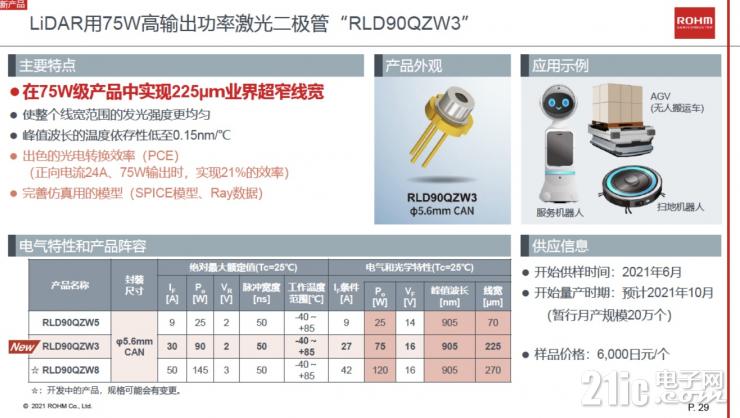How to make LiDRA detection achieve higher accuracy and longer distance? Analysis from the perspective of light source
Keywords: LiDAR FPLD VCSEL
[Guide] It is a system-level problem for LiDAR to achieve longer detection range and more stable performance. But the light source is the foundation of everything, and we recommend giving priority to the choice of light source. This article analyzes how the specific parameters of the light source affect the performance of the LiDAR system.
LiDAR originated in the 1960s. It is a combination of the words Light and Radar. The basic working principle can be seen from the naming. It uses a method similar to radio detection to emit light to the object to be measured and measure The time difference of its return is used to calculate the distance. With the continuous development of LiDAR technology, it has been widely used in iPhones and self-driving cars to realize 3D perception of the environment in recent years, and thus is well known by the public.

According to Yole's prediction, the overall LiDAR market will reach 3.8 billion U.S. dollars in 2025, with a compound growth rate of approximately 19% from 2019 to 2025. As the overall cost of LiDAR applications decreases, the penetration rate in robotics, autonomous driving, and industry will increase.
LiDAR system: a combination of optoelectronics, analog and digital
A typical LiDAR system includes optoelectronic chips, optical structures, analog circuits, digital circuits, and main control units. The light source uses pulsed laser diodes to emit pulsed light signals, and there are corresponding switches and drive chips and circuit designs on the back end. ; The emitted light needs to be sorted through a certain optical structure; the part that receives the light is the imaging unit, and also requires optoelectronic devices such as PD (photodiode), APD (avalanche diode) or SPD (single photon avalanche diode), and The signal conversion circuit at the back end; then according to the different processing methods of ToF, it will go through TDC or phase comparison later, and finally all the high data will be processed by the control unit (SoC/MCU, etc.). The following figure shows a specific example of a dToF type LiDAR system.

For LiDAR applications, detection accuracy, distance, range, resolution, etc. are the most important performance indicators. The choice of the three should be based on specific application scenarios to choose different technical solutions. At the system level, power consumption and cost are also important factors that need to be considered. Therefore, the current LiDAR technology is also very rich, and the technical routes of each company are also different. But from the deconstruction of the LiDAR system shown in the figure above, we can see that the light source is one of the most basic devices in the entire system and plays the most critical role; the performance of the light source will directly affect the overall performance.
ROHM recently held a press conference in Beijing to share the light source technology of LiDAR. This article will also focus on analysis from this perspective.
LiDAR mainstream optoelectronic devices: FPLD and VCSEL
There are LED, Vcsel, FP laser diode and other types of light sources. Among them, the pulsed light signal required by LiDAR mainly includes Vcsel and FPLD optical devices, which correspond to different 3DToF applications. According to Mr. Wu Bo, engineer of ROHM Beijing Technology Center, FPLD is also called edge-emitting LD, which is mainly used in rotating 3DToF. The laser light from the edge-emitting LD is shaped by the lens and hits the polygon mirror. The polygon mirror rotates 360 degrees continuously to perform an all-round scan. This kind of distance measurement method has better light-gathering properties, so the distance measurement is relatively far, which can reach more than 100 meters. The resolution depends on the scanning speed of the mechanical element. VCSEL is applied to illuminating 3DToF-the light emitted by VCSEL passes through a diffuser, for example, diffuses to a horizontal angle of about 120 degrees, and scans an object within the horizontal angle of 120 degrees. Illuminated 3DToF generally has better resolution, but because the light energy is relatively scattered, it is more difficult to use for long-distance ranging.

The light transmission paths of FPLD and VCSEL are also completely different. As shown in the figure below, the optical signal of FPLD is emitted from the side of the chip, while the optical signal of VCSEL is illuminated from the upper surface of the chip. When performing system integration, the arrangement of light sources is also different.

Transmitting power, light wave length, wavelength drift, modulation frequency, photoelectric conversion rate and line width lamp are particularly important parameters for light-emitting devices, which also have a direct impact on the overall detection capability of the LiDAR system.

It is reported that ROHM has achieved mass production of 780nm FPLD since 1984, and after more than 30 years of technological development and precipitation. As shown in the figure above, ROHM's previous laser diode product layout is concentrated on products with power below 100mW from 635nm to 780nm, while the current wavelength has been extended to 820-905nm, and the power level has been increased to 25W and 75W. Mr. Wu Bo said that there are two future development directions for ROHM's lasers: one is the high-power FPLD series at 905nm, and the other is that VCSEL will expand its product line in two directions below 4W and above 100W.

How ultra-narrow linewidth, light shape, and temperature dependence affect the performance of LiDAR
Many parameters of the laser have been mentioned above, but the influence of line width on performance in particular is not clear to many people. The 75W FPLD product RLD90QZW3 recently launched by ROHM has realized the industry's ultra-narrow 225µm luminous line width. Because the emitted light of the FPLD needs to pass through the lens to form parallel light before being shot out for scanning detection, the narrower the line width of the laser itself, the smaller the parallel spot after passing through the lens, and the stronger the light intensity in the center of the spot, so The detection distance is farther and the accuracy is higher. The line width of RLD90QZW3 laser is narrow enough, which is a very good feature for lidar applications.

The performance stability of lidar also needs the support of lasers to be better achieved. From the perspective of lasers, the light shape and temperature dependence are two important indicators. In addition to the narrow line width, another advantage of RLD90QZW3 is that its light shape is very good. As shown in the figure below, the luminous intensity in the entire line width range is more uniform than traditional products, and the luminous intensity at the edge of the light-emitting part is not significantly reduced or attenuated, which can help the lidar to achieve higher precision performance. In addition, the temperature drift performance of RLD90QZW3 is also more prominent, and the temperature dependence is increased by 40% compared with ordinary products. From the perspective of the LiDAR system, the photodetector (imaging side) can only allow light within a certain wavelength range to pass, so the smaller the wavelength of the light changes at different temperatures, the more stable the performance of the lidar will be. Therefore, the low temperature dependence of RLD90QZW3 can ensure that LiDAR achieves more stable imaging detection.

While pursuing line width, PCE (photoelectric conversion efficiency) will decrease. But ROHM's RLD90QZW3 did not compromise on PCE-while achieving ultra-narrow line width in 75W power class products, PCE performance achieved 21% consistent with ordinary products. Therefore, customers do not need to be troubled by power consumption while pursuing a longer detection range on the LiDAR system of this power level.

How to achieve ultra-narrow line width and excellent light shape without affecting PCE? ROHM said that this benefited from its patented production process and vertically unified production system. Advantageous processes include MOCVD-based crystal growth technology and refined processing technology combined with Wet-Dry etching; and the vertical unified production system from design to packaging and testing ensures the stability of its product quality. Specific technical details cannot be disclosed, but it is reported that its brand-new photonic crystal laser diode products are also under development.











